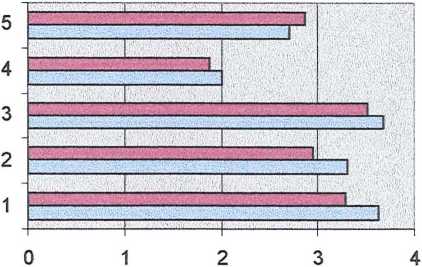239
• to what extent they agreed that competition between pupils could be used for
improving pupils’ motivation to Ieam mathematics.
Teachers of both age groups reported ‘sometimes’ attempting to improve satisfaction
and cohesiveness and reduce difficulties in mathematics classes. Teachers of both age
groups hardly ever noted friction in mathematics classes and tended to slightly disagree
that competition could be used for the promotion of pupils’ motivation to Ieam
mathematics. No statistically significant differences were found in the teachers’ attempts
to improve classroom ethos between teachers from the different age groups (Figure
7.3.2 and Table 7.3.4).
Figure 7.3.2: Mean scores of teachers’ perceptions of classroom ethos and their
attempts to improve classroom ethos (age group comparison)

□ 8th grade
teachers
□ 5th grade
teachers
I=Improving satisfaction, 2=lmproving cohesiveness, 3=Reducing difficulty
4=Notion Offriction, 5=Using competition for promotion of motivation
Table 7.3.4: Mean scores and Standard Deviation of teachers’ perceptions of classroom
ethos and their attempts to improve classroom ethos
|
5th grade teachers |
8m grade teachers | |||||
|
N |
M |
SD |
N |
M |
SD | |
|
Improving satisfaction: t=1.807, df=81, p>,05 |
43 |
3.63 |
.85 |
40 |
3.28 |
.93 |
|
Improving cohesiveness: t=1.855, df=86, p>.05 |
47 |
3.30 |
.88 |
41 |
2.95 |
.86 |
|
Reducing difficulty: t=. 933, dt=87, p>.05__________ |
47 |
3.68 |
.78 |
42 |
3.52 |
.80 |
|
Notion Qffriction: t=. 776, df=86, p>.05____________ |
46 |
2.00 |
.73 |
42 |
1.88 |
.71 |
|
Using competition for promoting motivation |
47 |
2.70 |
1.06 |
42 |
2.86 |
.93 |
The extent to which teachers’ reported attempts to improve their pupils’ satisfaction was
positively correlated with the extent of their reported attempts to reduce their pupils’
239
More intriguing information
1. Needing to be ‘in the know’: strategies of subordination used by 10-11 year old school boys2. The name is absent
3. Does Competition Increase Economic Efficiency in Swedish County Councils?
4. Plasmid-Encoded Multidrug Resistance of Salmonella typhi and some Enteric Bacteria in and around Kolkata, India: A Preliminary Study
5. A Review of Kuhnian and Lakatosian “Explanations” in Economics
6. Innovation Policy and the Economy, Volume 11
7. The Modified- Classroom ObservationScheduletoMeasureIntenticnaCommunication( M-COSMIC): EvaluationofReliabilityandValidity
8. The name is absent
9. References
10. Aktive Klienten - Aktive Politik? (Wie) Läßt sich dauerhafte Unabhängigkeit von Sozialhilfe erreichen? Ein Literaturbericht